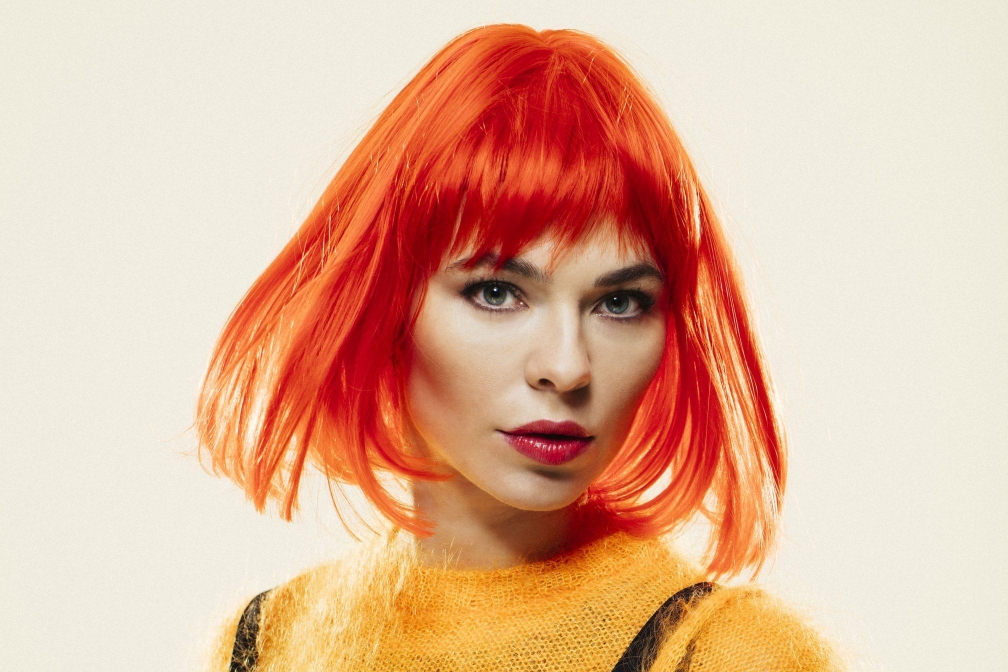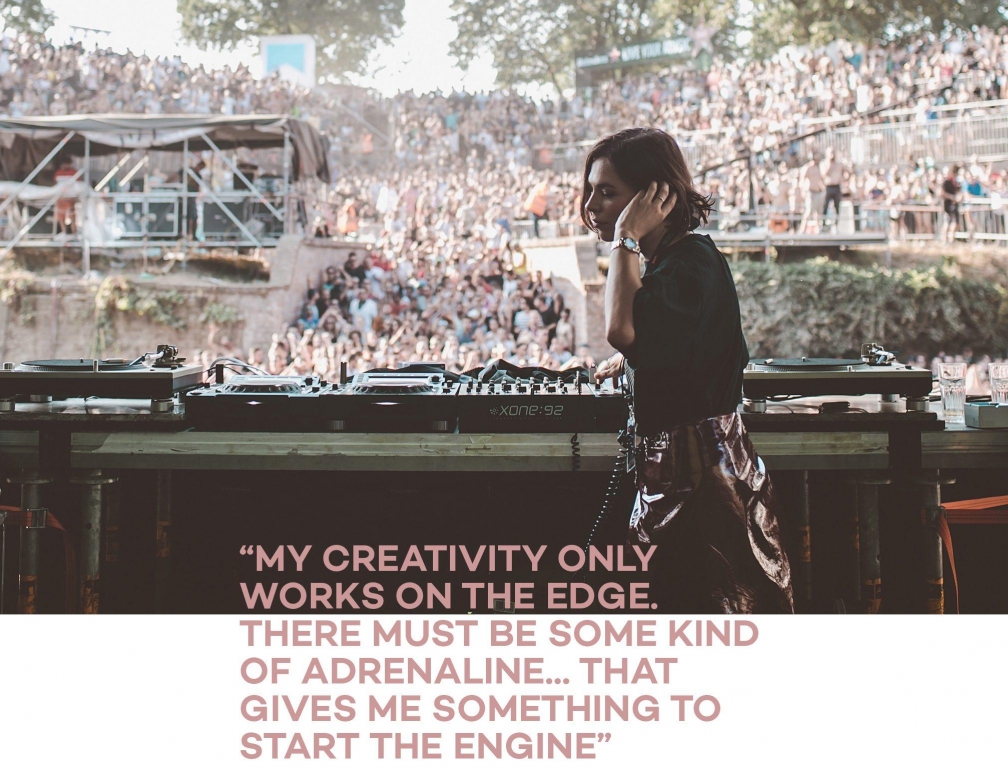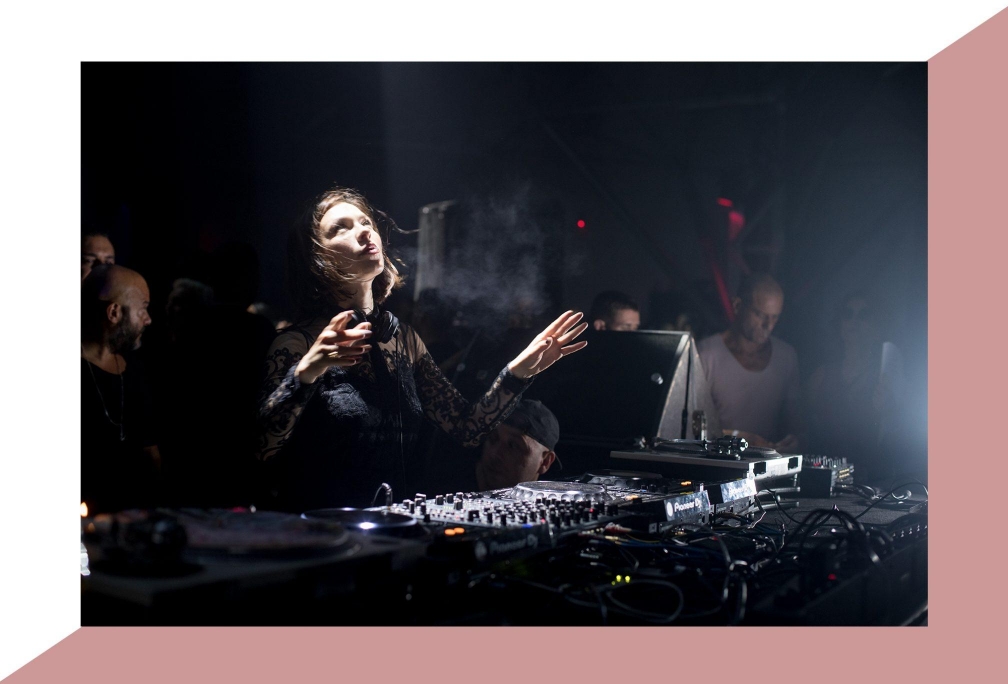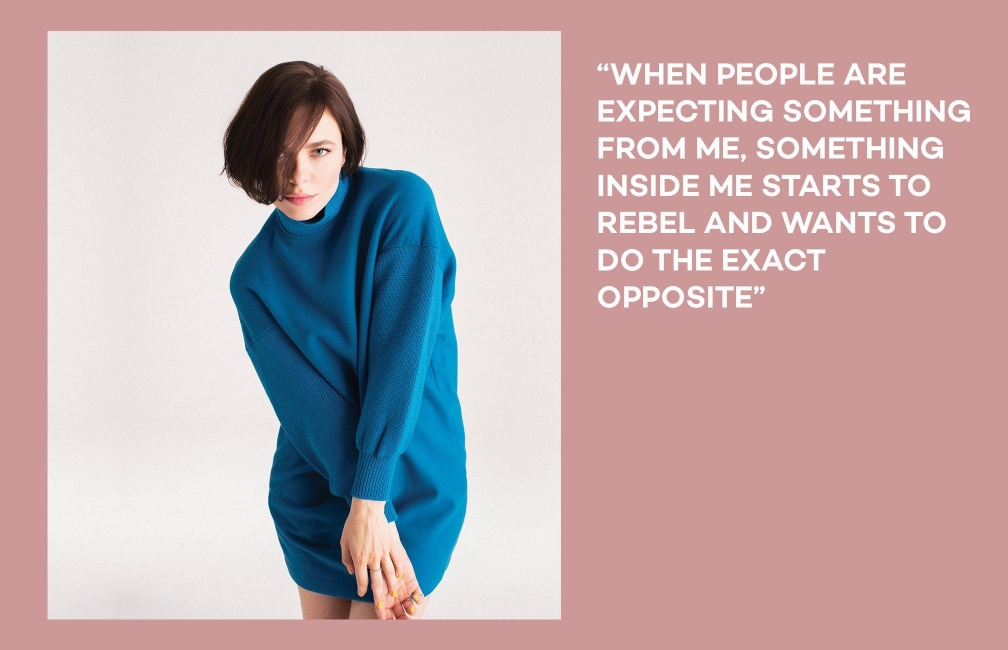 Features
Features
Nina Kraviz is our DJ of The Year
Fiercely independent, musically fearless and immersed in everything from acid techno to 80s pop
The windows of the Rush Hour record shop in Amsterdam are too steamed up to see through from the street, unless you squint through the remnants of a smiley face someone has drawn with a finger on the inside of the glass. Inside, sweat-drenched dancers cram into every whitewashed corner, jammed between listening stations, coats piled on shelves, record sleeves wilting in the heat and humidity. Hundreds more outside are bustling to get in. It’s 7pm and a record label’s in-store takeover has somehow become the hottest ticket at the city-wide Amsterdam Dance Event. The label is трип Recordings (pronounced ‘trip’). The DJ playing is Nina Kraviz.
Her presence (alongside Deniro, one of the many new artists she’s championed and promoted via the label), and the promise of three exclusive vinyl releases, only available at the party, turned this modest outlet on a narrow Dutch street into what its owner Antal calls ‘a sweaty club’ for two hours: “They were steady rocking!”
But Nina’s been rocking crowds of every size all year. In fact, 2017 has been yet another vertical incline for Kraviz. She’s starred everywhere from the world’s biggest stages (the superclubs of Ibiza, festival headline slots including sunrise at Sónar, closing Exit, Timewarp, Awakenings, Mutek and Kappa Futur) to the more experimental mien of Krakow’s Unsound and intimate shows in smaller venues like Robert Johnson and De School. And she’s done it on her own terms – if anything, as her profile has risen her sets have become more distinctive.
The bigger the stage the more fearless her selection; and the further away she has moved from the standard template of drops and builds the deeper she has explored what she calls ‘the continuum’ of electronic music. For anyone who hasn’t heard her play live, her 2017 Essential Mix is a good starting-point: an intense, primal exercise in everything that defines Nina the DJ (follow up with her b2b session with Mumdance at Unsound for Rinse FM for a taste of her astonishing range). Meanwhile, her ‘Pochuvstvui’ EP on Trip perfectly represents her evolution as a producer.
A couple of weeks after ADE, sitting in a hotel café in London, it strikes us that talking to Nina has a lot in common with hearing her DJ. Her conversation will seem to switch subject, meander, before returning to a unifying theme. Tall, slender, with a sleek yet severe bobbed haircut and wearing a camouflage T-shirt, her body language is positive and expressive: she rarely breaks eye contact and backs up her points with wide smiles and eyes and frequent laughter. When she talks about something more sombre, her whole mood changes – and so does yours. It’s no wonder she can get huge crowds to hang on her every move.

Born in the town of Irkutsk in Siberia, where huge Communist-era tower blocks loom over picturesque wooden houses built by 19th century political exiles banished there by the Tsar and temperatures can reach -35C in the winter and 35C in summer, Nina grew up in a family that held music in high regard. She was surrounded her father’s collection of rock, jazz, pop music and of course disco, sounds that are all still close to her heart (at the Mixmag cover shoot, she reveals a surprising love of Tina Turner). Moving through a range of professions, including studying medicine and working as a dentist, she also started DJing (rare groove, disco, funk and 70s soundtracks, with the acid techno that underpins so much of her music to this day becoming an increasing influence) and released a mix CD in 2006 called ‘Hi-Brow Dance’ (“disco with acid, classic stuff. Lots of different types of disco.”)
Her introduction to the music industry proper, though, was singing in a band with the somewhat zeitgeisty name of MySpaceRocket. The group recorded a whole album of music, but despite DJ pioneer and edit meister Greg Wilson being interested enough to sign two tracks, with a view to signing the whole LP, the project came crashing down. The band was unable to get the tracks up to release quality, and Nina’s offer to finish the album herself was dismissed out of hand. “They said, ‘No, you’re just a singer’. I said, ‘What do you mean I’m just a singer? I would bring ideas, and we would work on the creation of the songs together’ – but still they wouldn’t give me the parts,” she recalls. “I was so angry.”
It clearly still stings even now, but it also taught Nina a lesson she has never forgotten: never to let anyone else have control of her musical destiny. “When I made my first song I realised that I don’t need a band! It was such an eye-opening experience. I was so high on the idea that I could make music without anybody. And within four months, I had created so much.” It was Nina’s productions, rather than her DJ work, that provided her breakthrough – the ‘First Time’ EP on Underground Quality in 2008, followed up by ‘Pain In The Ass’ on Rekids and then of course her brilliant, self-titled debut album on the same label in 2012.
She continues to stand her ground. The Nina Kraviz you see playing on the world’s most prolific stages is very much a one-woman operation. She has no manager, no-one accompanying her on tour, and no-one else manages her label. “Most manager’s work is based on a distinctive structure,” she says, “and I sometimes have no interest in structure; I’m more interested in how it is flowing, how I am feeling – functioning on an intuitive level.”

It becomes clear that that rejection of structure, of expectations, is possibly Nina’s defining feature as a DJ, an artist and a person – from the risk she takes DJing by discarding the sync/EQ/build/drop template to the vulnerability she puts into her work as an artist, and her constant efforts to steer her crowd towards a deeper appreciation of dance music’s history and heritage. And when she feels the job is done, she moves on to the next thing.
One example is when she started a couple of years back to slip the odd classic trance banger into her sets, like her rework of Cherrymoon Trax’ ‘The House Of House’. The result was sheer dancefloor hysteria, and plenty of other DJs soon picked up on the trend – but Nina’s sets quickly moved on: “It’s less exciting when a lot of people are doing the same thing, and an impulse for me to do something new. For me the most exciting thing about art is that I don’t know exactly what kind of outcome it will bring. It makes it mysterious and mystic.”
Of course, away from the mysticism, the reality of being the DJ of the year is sometimes a little more prosaic. Walking through the crowds of fans and industry that are thronging Amsterdam, it becomes clear that getting a selfie with Nina Kraviz is somewhere near the top of many dance music fans’ bucket lists. In the club it’s even more intense, but she gracefully agrees to 90 per cent of the requests. “I’m very respectful of my fans, but I have a rule and I only take pictures with people I can interact with – in that I can look them in the eye for at least one minute of focus,” she says.
The mammoth venue for DGTL Festival holds around 10,000 people, and tonight it’s sold out. Nina is headlining alongside fellow techno royalty Modeselektor, Ryan Elliott and Jon Hopkins, and by the time she arrives on stage it’s almost 5am. The venue is still completely packed, though: the ADE spirit and an early-morning warehouse performance from Nina is enough to keep everyone firmly on the dancefloor.

It’s a tricky time to play: too soft and the audience may experience an energy lull, too hard and they lose focus before calling it a night. There is, of course, an element of crowd-reading here, but Kraviz has never really been a DJ who panders to the crowd’s expectations or desires: “It always gives me a weird feeling when people are expecting something from me,” she says, “something inside me starts to rebel and wants to do the exact opposite”.
She plays off the cuff (Nina never prepares her sets in advance), she projects herself through her music and she refuses to stay in one place. In her set she blisters through mutant techno, power-house and a curveball or two aimed at keeping people on their toes. The dBridge edit of ‘Deconstruction’ by Mathew Jonson provides a distinct U-turn in pace and is one of those moments that shows the breadth of Kraviz’s knowledge. “Music is a continuum connecting generations,” is how Nina explains her willingness to reach into any era for the right record for each moment; “you can play music made thirty years ago and it receives a new meaning by being reintegrated in a new context”. And despite its range, her DGTL set is a complete contrast to what she played at Dekmantel Festival in the same city earlier in the year, where she opened the Selectors Stage, a woodland paradise that hosts the best house, disco and funk at the event.
That three-hour masterclass was a disco rarity extravaganza, a chance for Kraviz to show off a completely different side to her sound, and her astonishing record-bag. ‘Spacer Woman’ by Charlie glides around the trees as she weaves it alongside tracks we’ve never heard before on a system, each beat seeming to glitter in the sunshine. But talking to Nina about her experiences this year we realise how much of a perfectionist she is. “I am the worst self-critic you can meet!” she laughs. “Providing something special is so important to me. Of course, people will be like, ‘Oh, that was really nice... we had so much fun’, but I know myself how I’ve played. I feel a little bit responsible if I feel like I could have given more. Sometimes it doesn’t work, and I feel horrible.”

One such time this year was at London’s Field Day festival. Her set took place in The Barn, a new steel structure for the festival that holds around 14,000 revellers, and Nina was given the slot before Aphex Twin’s first London appearance in about 14 years. It should have been one of the most memorable gigs of her career, but technical problems turned it instead into one of the most stressful of her career. “The people there wanted to have a nice time: they expected something and I didn’t give it to them. I don’t feel like a hero when that happens at all.”
She grimaces at the memory, but characteristically, she managed to take something bigger away from it. “You know what? At the same time, if you offered me a time machine so I could go back and change it, I’d say no – because with every experience I learn something new.”
She pauses and leans forward, and nails exactly why she’s such a compelling artist. “What has been pushing me all these years is my excitement about what I’m doing. I have to be excited about the music. My creativity only works on the edge. There must be some emotional edge or some kind of adrenaline that gives me something to start the engine, because I think that’s the whole part of me being a DJ: my biggest value in music is emotion. It’s a human being behind the decks.”
Along with her DJing, it’s the rise of her label this year that has lifted Nina Kraviz even higher. Трип (Trip) began life in 2014 and has since become one of the most singular, eclectic and visually profound imprints in dance music, its unconventional approach to the way it releases music and the music it puts out setting it aside from so many higher-scale operations.
Picking a name for the label was straightforward. “I love travelling,” explains Nina. “I try to integrate into different cultures. I’m a very, very curious person. Whenever a trip is being arranged, I get so excited – even sometimes when work is exhausting, I still love, love the idea of taking a trip.”

The label’s aesthetic, created by Nina and often drawn by Portuguese artist Tombo, fuses nightmarish scribblings with an emotional connection to the music and artists creating it. As for the music, it’s about unearthing talent beyond the spotlight; artists like Deniro, Biogen, PTU, Exos, Roma Zukermann and more: unique DJs and producers who promote unique strands of techno, electro and acid.
“I really like the fact that she isn’t going for the usual big names on her label,” says Dutchman Deniro, who first met Nina at Dekmantel in 2014. “She’s always looking for new artists who have a style of their own. Not copycats,” he continues. “I get the sense that she really feels the tracks I’ve made, the same way I do.”
Deniro’s ‘Organezized’ featured on one of Trip’s earliest EPs, ‘De Niro is Concerned’, and his latest seven-track EP ‘Mendoza’ has just dropped. Perhaps the biggest breakthrough on the label so far, though, is Bjarki, the Icelandic producer responsible for ‘I Wanna Go Bang’, one of 2015’s biggest tunes and one that demonstrated just how Trip’s weirdo, leftfield output could connect with a vast audience. Played out by everyone from Moodymann to Skream, it shot both Bjarki and Trip to a new level of recognition, and theyfollowed it up with more music. A lot more: since ‘I Wanna Go Bang’, Bjarki has released three albums on Trip and there have been nearly 20 further EPs from the imprint’s roster.
This year, Biogen, PTU and Deniro’s EPs have broken the mould with wildly innovative, at times abrasive electronic music, as did ‘Hessdalen’, Volruptus’ wild, five-track electro excursion. Combined with the releases have come the second strand of Trip’s unique aesthetic: its equally unique, off-beat label parties.
Set in weird, wonderful and wild locations around the world, a Trip party strives to be everything a normal party isn’t, soundtracked by a collective of artists riding the same wavelength. There was a rave in Helsinki at the top of a water tower, an event at the San Diego Air & Space Museum where Kraviz and Bjarki bopped beneath rockets, and a rave in cave in remotest Iceland. Meanwhile Nina’s second label, GALAXID, is set to return with albums from Species Of Fisher, Solar X, and an artwork collaboration with Japanese painter Keiichi Tanaami.
Interview over, we head to another record shop, London’s Kristina, which owner Jason Spinks has kept open late especially. He greets Nina with a stack of techno (including, of course, some rarities from her beloved Dance Mania). Her eyes light up, and she spends two-and-a-half hours with the store all to herself, either playing tracks with laser focus or systematically sorting through the records in each aisle. Away from the crowds and the selfies, single-mindedly digging through the history of dance music, Nina Kraviz is in her element.
Aleksi Perälä ‘Paradox’ is released on Trip on December 15. Nina will play NYE at Hyte Berlin, Ampere Antwerp and Ahoy Rotterdam; Awakenings in Amsterdam on January 27; and Junction 2 in London and Bristol in February


